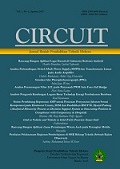Miniatur Rel Kereta Api Cerdas Indonesia Berbasis Arduino
DOI:
https://doi.org/10.22373/crc.v2i2.3701Keywords:
Arduino, Raindrop, LDR, LM35, Servo, Automatic roofAbstract
In designing a system in facilitating the work in operating the door bar and the lights of the railroad tracks that sometimes require quite a lot of employees because this kind of problem often occurs because of negligence in operating a lot of accidents that occur in the railroad crossing. For this reason, the researchers designed a miniature intelligent railroad system that is expected to help streamline the operation of the doorstop and turn on the lights off the hallway automatically. The way this tool works is by utilizing the arduino microcontroller, the Infra Red sensor and the Ultrasonic sensor as the data input provider and the prototype's working method. The Infra Red 1 sensor will provide input when the train passes and the crossing bar will close, the Infra Red 2 sensor will open the crossbar the crossing door when the train has passed the crossing of the crossing door and gives a welcome message on the LCD, when the train enters the hallway the Ultrasonic sensor will turn on, control the led to adjust the net of the train that goes through the work process over and over.
Downloads
Published
Issue
Section
License
Authors who publish in CIRCUIT: Jurnal Ilmiah Pendidikan Teknik Elektro agree to the following terms:
- Authors retain copyright and grant the journal right of first publication with the work licensed under a Creative Commons Attribution-ShareAlike 4.0 International License (CC BY-SA 4.0) that allows others to share and adapt the work with an acknowledgement of the authorship and initial publication in this journal
- Authors are able to enter into separate, additional contractual arrangements for the non-exclusive distribution of the journal's published version of the work (e.g., post it to an institutional repository or publish it in a book), with an acknowledgment of its initial publication in this journal.
- Authors are permitted and encouraged to post their work online (e.g., in institutional repositories or on their website) prior to and during the submission process, as it can lead to productive exchanges, as well as earlier and greater citation of published work. (See The Effect of Open Acces)

